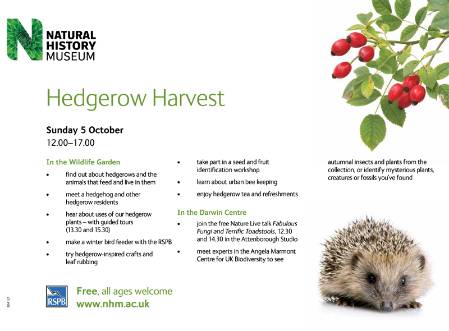With the recent warm sunny weather here its hard to believe that it is officially autumn – but watching our surrounding shrubs and trees, their leaves and berries remind us that it has been here a while.
Join us this weekend for Hedgerow Harvest, a free family event with activities, crafts, guided tours and many other things to see and do. We'll be in the Wildlife Garden and Darwin Centre this Sunday 5 October between 12.00-17.00.
Larissa, in a berry mood, tells us more about our hedgerow bounty:
Here in the Wildlife Garden we have hedgerows marking some of the boundaries of the different British habitats in the garden. These hedges are managed for wildlife such as the blackbirds and wrens which nest in them and the mice and amphibians that take cover in them.
One of our hedgerows in the Wildlife Garden.
© Jonathan Jackson
Hedgerows are an important feature of the British landscape and although figures from the Wildlife Trusts suggest hedgerows stretch around 450,000km at present, this is much lower than historic levels.
According to the RSPB, hedgerows provide nesting habitat for around 30 species of British birds. In fact 80% of British woodland bird species, 50% of British mammals and 30% of our butterflies make use of them either as a habitat, food source or cover (RSPB). Take a look at the RSPB website to discover more about hedgerows for wildlife.
Butterflies such as the peacock (Aglais io) forage for nectar from the flowers in our hedgerows.
© Tony Buckle
Now we are moving into autumn and the leaves are beginning to change colour, the hedges usually fill with fruits and berries. However in July this year – almost two months earlier than previous years, we found ripe elderberries (Sambucus nigra) in the garden and the rowan (Sorbus aucuparia) trees were dripping with red berries. All of these fruits have gone already, which won’t be good news for the mistle thrush which visited to feed on our rowan berries up until January this year.
Elderberries by our main pond in July this year. The blackbirds didn't take long to eat them all.
Bright red rowan berries in July.
© Jonathan Jackson
In comparison, this January the trees were still full with last year’s fruits, which attracted two mistle thrush to the garden from late autumn until January.
These early autumnal signs weren’t just a local occurrence either – the Woodland Trust had reports through their Nature's Calendar from across the country from July onwards. You can submit your own records on the Woodland Trust’s Nature’s calendar.
One of the great things about hedgerows is not just the benefits to wildlife, but the bounty of wild produce they can bring to your kitchen if you know where to look. This year and 2013 have been bumper years for fruit and some of us have taken advantage of this. August brambles (Rubus fruticosus agg.), a handful of crab apples (for natural pectin) and a leisurely walk resulted in a couple of jars of delicious bramble jam, not to mention the elderberry and bramble wine bubbling away in my conservatory at home. Unfortunately the wine takes a year or so before it is ready, but it’ll be a nice Christmas treat for next year!
Brambles in August in the Wildlife Garden.
©Jonathan Jackson
Bramble jam.
© Larissa Cooper
Add in a few crab apples to the bramble jam (or other jams and jellies) to add natural pectin to assist with the setting.
© Larissa Cooper
Elderberry wine bubbling away. Fermentation has slowed but the flavour still needs to develop. We added in some brambles to sweeten the wine slightly.
©Larissa Cooper
My colleague Chris Raper in the Angela Marmont Centre for UK Biodiversity has been busy foraging too, having more luck than me at finding sloes (fruits from the blackthorn Prunus spinosa) and putting them to good use making sloe gin.
Plenty of sloes this year if you know where to find them.
© Chris Raper
Sloe gin in the making.
© Chris Raper
If there were any rowan berries left some could be used to make rowan jelly, much like hawthorn (Cratageus monogyna) jelly, a foraged alternative to cranberry jelly for your roast dinner. Hazel (Corylus avellana) nuts are delicious toasted – if you can get there before the squirrels that is. Rosehips also make a delicious sweet jelly, and our hops donated by Meantime Brewery last year have done very well this year – beer anyone?!
One thing to remember though – when foraging, be sure to leave something for the hedgerow inhabitants as it is their supermarket after all!
The hops in our hedgerow have almost taken over in some parts, but we shall be leaving them for wildlife and because they look so beautiful.
© Larissa Cooper
To find out more about hedges, and taste some hedgerow produce, Join us at our Hedgerow Harvest event this Sunday 5 October in the Wildlife Garden and Darwin Centre between 12.00-17.00.
Some of the delicious produce made from hedgerow plant species.
© Photoshot, Natural History Museum
Hedgerow Harvest - join us this Sunday 5 October between 12.00-17.00.
You can also find out more about the biodiversity of hedgerows in the autumn edition of evolve magazine.



![1. CBNQO9_k3QrGmiBxptM9BswR5N2Pv5DB9ha4u_X8OZ0[1].jpg](../../../../../servlet/JiveServlet/downloadImage/38-3895-85688/450-428/1.+CBNQO9_k3QrGmiBxptM9BswR5N2Pv5DB9ha4u_X8OZ0[1].jpg)
![2. zQrqiRygurlhVD-EzfSYAbhUV6T3goYniKmJu4mZqwQ[1].jpg](../../../../../servlet/JiveServlet/downloadImage/38-3895-85689/450-444/2.+zQrqiRygurlhVD-EzfSYAbhUV6T3goYniKmJu4mZqwQ[1].jpg)
![3. z-VBGC4sMN7q9oLVeAiw407uAuJ7P2OljNJc34zwuYk[1].jpg](../../../../../servlet/JiveServlet/downloadImage/38-3895-85690/450-444/3.+z-VBGC4sMN7q9oLVeAiw407uAuJ7P2OljNJc34zwuYk[1].jpg)
![4. 5c9fyKw7_WRtCzEd08NRHuy9u16xcXM0UCJYbwXy6O8[1].jpg](../../../../../servlet/JiveServlet/downloadImage/38-3895-85691/450-433/4.+5c9fyKw7_WRtCzEd08NRHuy9u16xcXM0UCJYbwXy6O8[1].jpg)
![5. 3PTgYC5OWiWO6eRmIbw6A2s7qcFrpRZn9YlwQrgCZwY[1].jpg](../../../../../servlet/JiveServlet/downloadImage/38-3895-85692/450-451/5.+3PTgYC5OWiWO6eRmIbw6A2s7qcFrpRZn9YlwQrgCZwY[1].jpg)
![6. qz-atsro-gAMIO8tAtdbMJw_Ldpz5NjQsTHKWKZ_FM8[1].jpg](../../../../../servlet/JiveServlet/downloadImage/38-3895-85693/450-447/6.+qz-atsro-gAMIO8tAtdbMJw_Ldpz5NjQsTHKWKZ_FM8[1].jpg)
![7. XCnLJwmKAF8W7rKH8QKatnlxFZukG8EdKw9pv932PqY[1].jpg](../../../../../servlet/JiveServlet/downloadImage/38-3895-85694/450-434/7.+XCnLJwmKAF8W7rKH8QKatnlxFZukG8EdKw9pv932PqY[1].jpg)
![8.1GYRL0_RBjJPRTrMNFzO2mrYYHGDmsIOdwEfWREn4x0[2].jpg](../../../../../servlet/JiveServlet/downloadImage/38-3895-85695/450-428/8.1GYRL0_RBjJPRTrMNFzO2mrYYHGDmsIOdwEfWREn4x0[2].jpg)
![9. WKJtAb6-UKDFZsm5eGiH9jIzgHJDFSisBWRHCsdqYAU[1].jpg](../../../../../servlet/JiveServlet/downloadImage/38-3895-85696/450-442/9.+WKJtAb6-UKDFZsm5eGiH9jIzgHJDFSisBWRHCsdqYAU[1].jpg)
![10. 1atkR9OOYpPhGIwKiV0N7Stqm1lPXe6kjjqV5y_ITRI[1].jpg](../../../../../servlet/JiveServlet/downloadImage/38-3895-85697/450-430/10.+1atkR9OOYpPhGIwKiV0N7Stqm1lPXe6kjjqV5y_ITRI[1].jpg)
![11. bCClUGGoaODrmwwkisGMnN3dZ4psGCMS4t05pY2O7xU[1].jpg](../../../../../servlet/JiveServlet/downloadImage/38-3895-85698/450-438/11.+bCClUGGoaODrmwwkisGMnN3dZ4psGCMS4t05pY2O7xU[1].jpg)
![12. 3AqXMn4FlAKLbSEIiB4fjfMd7W6pMpV_VeRkPolDgfc[1].jpg](../../../../../servlet/JiveServlet/downloadImage/38-3895-85699/450-443/12.+3AqXMn4FlAKLbSEIiB4fjfMd7W6pMpV_VeRkPolDgfc[1].jpg)
![13. O7OGmVxCC5G1rdBSwDH9f3iFioQ3VxahY5kABl5H_4s[1].jpg](../../../../../servlet/JiveServlet/downloadImage/38-3895-85700/450-445/13.+O7OGmVxCC5G1rdBSwDH9f3iFioQ3VxahY5kABl5H_4s[1].jpg)
